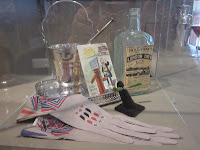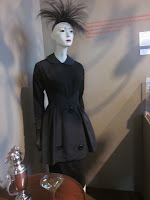It was the time of the Prohibition...1920-1932. The Lutherans had decided that we were living in an era of too much laxity. People were indulging in too much drinking and other "forbidden" pleasures which were bad for the spirit, good morals and health, and decided to push the government into giving laws which would ban the sale of liquor. The Women's Temperance association, which had been pressing the government since 1826 for laws against drinking, blaming it as a cause of poverty, domestic, violence and crime, finally got its wish along with the members of the progressive movement who sought to improve society and political life through social and technological progress, which could only be possible getting rid of excesses in mercantilism, of social injustice and political corruption. The latter sought for reforms in health laws, social security , unemployment laws, minimum salary for women, federal warranty for bank deposits, 8 hour working day, income tax and a ban on liquor which was considered the origin of political corruption (they said that politicians gathered in saloons to discuss loopholes in the law.) Furthermore, with the engagement of the US in World War, there was an urge to save money used in the production of grain for liquor for war expenses. This last motive, it lost its validity because war was over before the Prohibition.
And so it was that in 1920 Congress approved the National Prohibition Act which through the Volstead Act, specified in detail what was considered "bad liquor" and the penalties associated with its use (wine for religious celebrations and domestic wine for farmers uses were an exception). Section 29 of the Volstead Act allowed the making at home of wine and cider from fruit (but not beer). Up to 200 gallons per year could be made, and some vineyards grew grapes for home use. Also, one anomaly of the Act as worded was that it did not actually prohibit the consumption of alcohol; many people actually stockpiled wines and liquors for their own use in the latter part of 1919 before sales of alcohol became illegal the following January.
The prohibition was not well taken by the majority of the population among the United States, and the illegal consumption of alcohol generalized among them. The clandestine production of the so called spirits increased and corruption augmented, leading to the creation of organized crime. The sale of alcohol was monopolized by the mafia and was backed by corrupt government employees. Physicians prescribed whisky for medical reasons and more than 4 million liters of alcohol were sold every year. Federal Agents killed more than 200 suspects between 1920 and 1927 and law was not the same for everyone. President Harding had great amount of liquor reserves in the White House and alleged "this was due to very important State reasons".
All kinds of tricks to violate the law went into effect, like the sale of the wine bricks or liquid and semisolid grape concentrates by a company called Vino Sano (healthy wine), which was sold with a warning: "After dissolving the brick in a gallon of water, do not place the liquid in a jug away in the cupboard for twenty days, because then it would turn into wine." One grape block producer sold nine varieties: Port, Virginia Dare, Muscatel, Angelica, Tokay, Sauterne, Riesling, Claret and Burgundy.
Also, there was a flourishment of the "speakeasy (you got to be moderate and sleek in your behavior, so you wouldn't be caught by enforcement agents) establishments", which were high-end clubs, which offered food and entertainment and demanded strict elegant dress codes. In Chicago, for example, Al Capone got to own all of these establishments. There were other places called "blind pigs", which only sold liquor and beer and would use the excuse of being open for animal sights.
This was the time of the flappers or liberal ladies, who started to be frequent patrons in the clubs and used special and unconventional loose dresses and elaborate jewelry, smoked cigaretes and hid bottle flasks attaching them to garters under their dresses. It was the time when women were being granted the right to vote and the liberal movements were on vogue.
It also, as we shall see, was the cocktail culture era; in which cocktails were served, supposedly as fruit juice, to hide their alcohol contents.
The government realized that the consequences of this moralistic approach had been worse than freedom in the people decision and soon Congress divided and the "wet" Democrats got their way.
It was with President Roosevelt that there was an amendment to the National Prohibition Act in 1933 and this infamous period ended.
The following exhibit which I am about to present is currently ongoing in Planting Fields Arboretum
National Historic Park in Long Island, the former home of William Robertson Coe, who established the Foundation for the enhancement and development of his former 400 acres estate, Planting Fields in Oyster Bay, New York, on the famous Gold Coast, home of many rich entrepreneurs at the time. William Robertson Coe (June 8, 1869 – March 15, 1955) was an insurance, railroad and business executive, as well as a horse breeder and collector of Americana and an important philanthropist for the academic discipline of American Studies. He had four children by his second wife Mai Rogers, daughter of an oil industrialist. After the death of Mai, William married Carolyn Graham Slaughter.
Coe lived through the prohibition area and in his mansion, he stockpiled enormous amounts of liquor of which he carefully kept track.
The exhibition has been named:
Cocktail Culture: The Gold Coast Years From Prohibition to 1960
"The cocktail is a quintessentially American drink, embodying a unique mix of innovation, modernity and glamour. The exhibition begins with the era of Prohibition in the 1920s which, on Long Island, has a rich and fascinating history. The show explores forty years of sweeping social changes and constant transformations of styles in fabulous clothes and fashion accessories. A cocktail is more than just a drink; the word conjures up the intermingling of company and the mixing of fashions to achieve a balanced, yet stimulating social concoction. To this day cocktails remain a vital force in cosmopolitan American culture." (The Planting Fields Foundation)
 |
| Cole Hall |
 |
| William Coe |
 |
| Cocktail Culture: The Glamorous Gold Coast Years From Prohibition to 1960 |
 |
| Newspaper article about the oncoming Prohibition |
 |
| Bottom of the article above |
 |
| The NY Times published a page about the exhibition |



























































No hay comentarios.:
Publicar un comentario